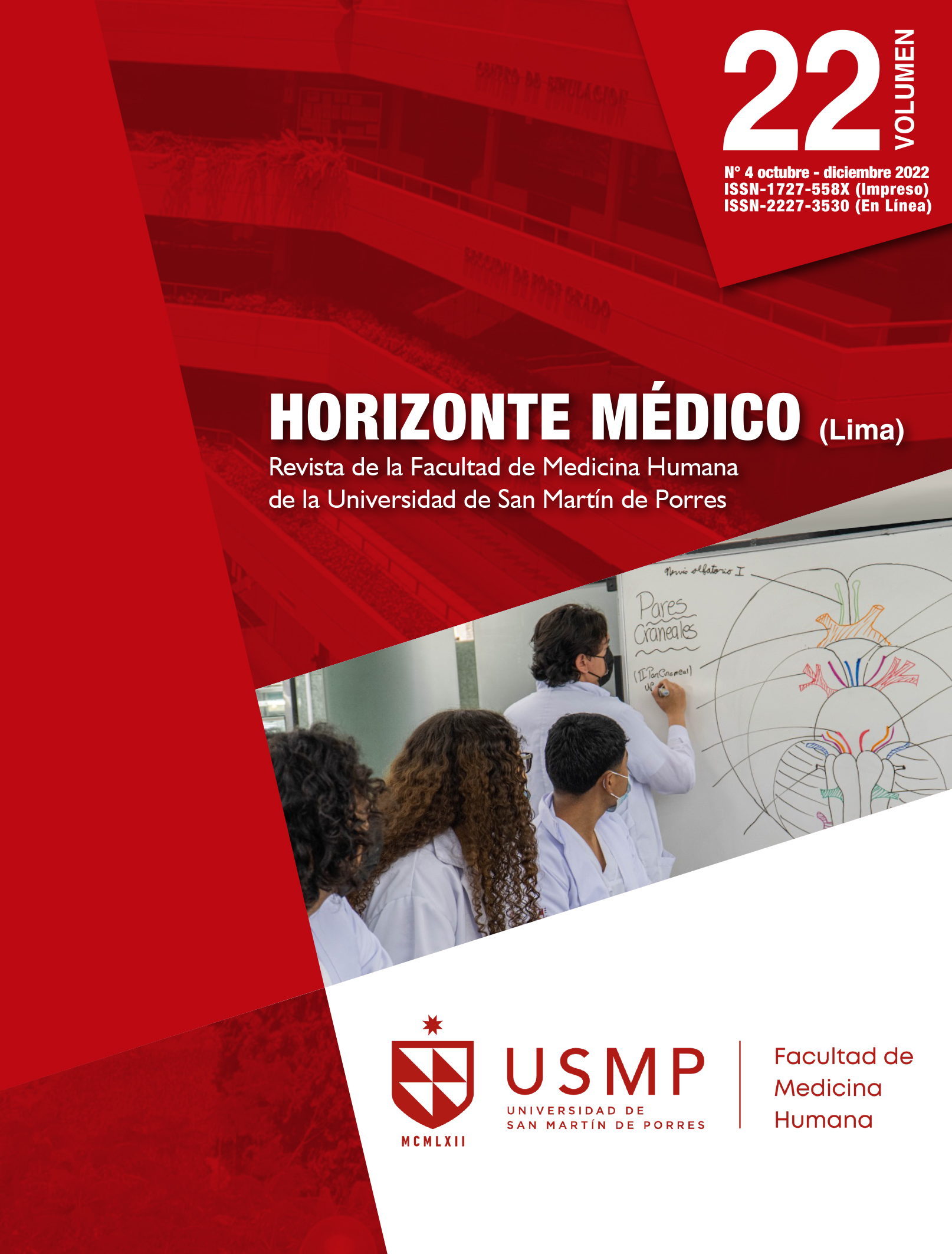Correlation between eosinophil count and total protein and alkaline phosphatase in asymptomatic patients with normal and high levels of aspartate aminotransferase from a polyclinic in Villa El Salvador, Lima, Peru
DOI:
https://doi.org/10.24265/horizmed.2022.v22n4.01Keywords:
Alkaline Phosphatase, Eosinophils, Statistics, NonparametricAbstract
Objective: To evaluate the correlation between eosinophil differential count and total protein and alkaline phosphatase levels in patients with normal and high levels of aspartate aminotransferase from a polyclinic in the district of Villa El Salvador in Lima, Peru. Materials and methods: An observational, analytical and correlational study conducted with apparently healthy male and female patients aged 18 years or older, showing normal and high levels of enzyme aspartate aminotransferase. The study included 279 patients who met the eligibility criteria. Spearman's correlation coefficient was used to determine the correlation between eosinophil count and alkaline phosphatase and total protein in patients with normal and high levels of aspartate aminotransferase. Results: No correlation was found between the variables studied in the group with normal levels of aminotransferases. However, in the group with high levels of aspartate aminotransferase, a moderate and negative correlation was found between eosinophil count and total protein (Rho = -465) and a low and positive correlation between eosinophil count and alkaline phosphatase (Rho = 296). Conclusions: In the presence of aminotransferase levels above the normal range, eosinophils correlate with total protein and alkaline phosphatase. Further studies with a larger number of patients and greater methodological complexity are necessary to determine if the interaction between eosinophils and albumin and phosphatase is frequently seen with high levels of aminotransferases. Moreover, they are necessary to consider possible implications in the pathophysiology of chronic diseases associated with this enzyme, as well as possible clinical and therapeutic implications.
Downloads
References
Agganis B. Enzimas hepáticas [Internet]. Intramed.net; 2020. Disponible en: https://www.intramed.net/contenidover.asp?contenidoid=93082
Gallo P, De Vincentis A, Bandinelli S, Ferrucci L, Picardi A, Incalzi RA, et al. Combined evaluation of aminotransferases improves risk stratification for overall and cause-specific mortality in older patients. Aging Clic Exp Res. 2021; 33(12): 3321-31.
McGill MR. The past and present of serum aminotransferases and the future of liver injury biomarkers. EXCLI J. 2016; 15: 817-28.
Malakouti M, Kataria A, Ali SK, Schenker S. Elevated liver enzymes in asymptomatic patients - what should I do? J Clin Transl Hepatol. 2017; 5(4): 394-403.
Angulo N, Szarvas SB, Guevara H, González D, Hernández A. Pruebas de función hepática en escolares obesos. Invest Clin. 2015; 56(1): 13-24.
Putri RR, Casswall T, Hagman E. Prevalence of increased transaminases and its association with sex, age, and metabolic parameters in children and adolescents with obesity - a nationwide cross-sectional cohort study. BMC Pediatr. 2021; 21(1): 271.
Díez-Vallejo J, Comas-Fuentes A. Hipertransaminasemia asintomática en Atención Primaria. Rev Esp Enferm Dig. 2011; 103(10): 530-5.
Peña C, Ortiz M, Voisin J, Peralta A, Balboa V, Delgado F. Precisión diagnóstica de electroforesis de proteínas séricas y mediciones de cadenas ligeras libres para gammapatías monoclonales. Rev Med Chil. 2018; 146(1): 64-7.
Aguilera JCG, Lavernia JOC, Garcés GMM, Artímez MEP. Albúmina sérica como factor pronóstico de caída múltiple de órganos en pacientes con peritonitis difusa secundaria. MEDISAM. 2020; 24(4): 627-40.
Vaillant AAJ, Jamal Z, Ramphul K. Inmunoglobulina. Es: StatPearls [Internet]. StatPearls Publishing; 2022. Disponible en: https://www.ncbi.nlm.nih.gov/books/NBK513460/
Conlledo R, Rodríguez Á, Godoy J, Merino C, Martínez F. Globulinas totales y recuento linfocitario como marcadores de mortalidad en sepsis y shock séptico. Rev Chil Infectol. 2012; 29(2): 192-9.
Bruce AEA, Pérez YT, Quesada MC. Utilización práctica del laboratorio en las enfermedades hepáticas. Rev Med Electrón. 2019; 41(5): 1217-29.
Fettrelet T, Gigon L, Karaulov A, Yousefi S, Simon HU. The enigma of eosinophil degranulation. Int J Mol Sci. 2021; 22(13): 7091.
Yasuda K, Kuroda E. Role of eosinophils in protective immunity against secondary nematode infections. Immunol Med. 2019; 42(4): 148-55.
Jackson DJ, Akuthota P, Roufosse F. Eosinophils and eosinophilic immune dysfunction in health and disease. Eur Respir Rev. 2022; 31(163): 210150.
Zhu L, Fang Z, Jin Y, Chang W, Huang M, He L, et al. Association between serum alanine and aspartate aminotransferase and blood pressure: a cross-sectional study of Chinese freshmen. BMC Cardiovasc Disord. 2021; 21(1): 472.
Kunutsor SK, Abbasi A, Apekey TA. Aspartate aminotransferase - risk marker for type-2 diabetes mellitus or red herring? Front Endocrinol. 2014; 5: 189.
Morgan W. The liver and its diseases, both functional and organic. Their history, anatomy, chemistry, pathology, physiology, and treatment [Internet]. Legare Street Press; 2021. Disponible en: https://www.ncbi.nlm.nih.gov/books/NBK535438/
He K-P, Zhao C, Qiang Y, Liu H-R, Chen N, Tao X-J, et al. Impact of elevated aspartate and alanine aminotransferase on metabolic syndrome and its components among adult people living in Ningxia, China. Chronic Dis Transl Med. 2015; 1(2): 124-32.
Shafran N, Issachar A, Shochat T, Shafran IH, Bursztyn M, Shlomai A. Abnormal liver tests in patients with SARS-CoV-2 or influenza - prognostic similarities and temporal disparities. JHEP Reports. 2021; 3(3): 100258.
Rahim MN, Miquel R, Heneghan MA. Approach to the patient with acute severe autoimmune hepatitis. JHEP Reports. 2020; 2(6): 100149.
Podgórska J, Werel P, Klapaczyński J, Orzechowska D, Wudarski M, Gietka A. Liver involvement in rheumatic diseases. Reumatologia. 2020; 58(5): 289-96.
Oh RC, Hustead TR, Ali SM, Pantsari MW. Mildly elevated liver transaminase levels: Causes and evaluation. Am Fam Physician. 2017; 96(11): 709-15.
Xu L, Yang Y, Wen Y, Jeong J-M, Emontzpohl C, Atkins CL, et al. Hepatic recruitment of eosinophils and their protective function during acute liver injury. J Hepatol. 2022.
Lala V, Goyal A, Minter DA. Liver function tests. En: StatPearls [Internet]. StatPearls Publishing; 2022. Disponible en: https://www.ncbi.nlm.nih.gov/books/NBK482489/
Echeverría F, Valenzuela R, Espinosa A, Bustamante A, Álvarez D, Gonzalez-Mañan D, et al. Reduction of high-fat diet-induced liver proinflammatory state by eicosapentaenoic acid plus hydroxytyrosol supplementation: involvement of resolvins RvE1/2 and RvD1/2. J Nutr Biochem. 2019; 63: 35-43.
Shibata M, Nakajima K, Higuchi R, Iwane T, Sugiyama M, Nakamura T. High concentration of serum aspartate aminotransferase in older underweight people: Results of the Kanagawa investigation of the total check-up data from the national database-2 (KITCHEN-2). J Clin Med. 2019; 8(9): 1282.
Lowe D, Sanvictores T, John S. Alkaline phosphatase. En: StatPearls [Internet]. StatPearls Publishing; 2021. Disponible en: https://www.ncbi.nlm.nih.gov/books/NBK459201/
Sharma U, Pal D, Prasad R. Alkaline phosphatase: an overview. Indian J Clin Biochem. 2014; 29(3): 269-78.
Rader BA. Alkaline phosphatase, an unconventional immune protein. Front Immunol. 2017; 8: 897.
Sciacqua A, Tripepi G, Perticone M, Cassano V, Fiorentino TV, Pitito GN, et al. Alkaline phosphatase affects renal function in never-treated hypertensive patients: effect modification by age. Sci Rep. 2020; 10(1): 9847.
Published
How to Cite
Issue
Section
License
Copyright (c) 2022 Horizonte Médico (Lima)

This work is licensed under a Creative Commons Attribution 4.0 International License.
Horizonte Médico (Lima) (Horiz. Med.) journal’s research outputs are published free of charge and are freely available to download under the open access model, aimed at disseminating works and experiences developed in biomedical and public health areas, both nationally and internationally, and promoting research in the different fields of human medicine. All manuscripts accepted and published in the journal are distributed free of charge under the terms of a Creative Commons license – Attribution 4.0 International (CC BY 4.0).


















